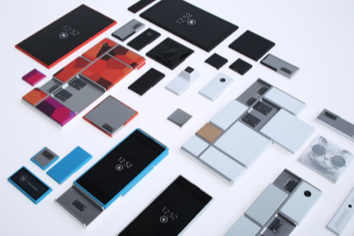The critical and consumer response to Motorola Mobility’s Moto X launch this summer was a mixed bag. The phones were nice enough, but many expected the first Motorola phones released under the Google regime to stretch the techno limits, Nexus style. One feature, however, stood out as a bold move: the somewhat Dell-like MotoMaker service that provided online customization of styling, memory, and accessories.
 With this week’s announcement of Motorola’s Project Ara, it’s clear that customization is more than just a gimic to Motorola and Google. The open source project aims to build a modular smartphone platform that lets users customize their phones on a more fundamental level, while also swapping out parts for upgrades.
With this week’s announcement of Motorola’s Project Ara, it’s clear that customization is more than just a gimic to Motorola and Google. The open source project aims to build a modular smartphone platform that lets users customize their phones on a more fundamental level, while also swapping out parts for upgrades.
Defined by Motorola as a “free, open hardware platform for creating highly modular smartphones,” Project Ara aims to “create a vibrant third-party developer ecosystem, lower the barriers to entry, increase the pace of innovation, and substantially compress development timelines.” Motorola will build the endoskeleton (endo) while third parties will build snap-on modules including processors, displays, keyboards, battery extensions, and sensor devices such as pulse oximeters, says the company.
Motorola says it has been developing Project Ara for a year, but has now decided to partner with Phonebloks, which has been working on a similar concept. On Oct. 29, the Dutch startup met its Thunderclap goal of 900,000 supporters, reaching a total of 979,264. No money changed hands, but it’s still an impressive tally, suggesting that consumers are looking for something new from their smartphones.
Motorola has begun asking the Phonebloks community for input, and will soon send out invitations to developers to start building modules, possibly with prize incentives. An alpha release of the Module Developer’s Kit (MDK) is expected this winter.
Open source hardware inspiration
Project Ara could not exist today without the success of open hardware projects like Arduino, Raspberry Pi, and BeagleBoard.org. Such projects have already brought a modular approach to embedded computing. Their shields, capes, and module extensions are simply less integrated versions of the Phonebloks’ bloks. For a more polished example that looks like consumer electronics, there’s inspiration to be found in Bug Labs’ open source Linux “Bug” embedded computers, which feature over a dozen Bug Block modules.
For a phone example, the already numerous critics of Project Ara and Phonebloks point out that the now-defunct Modu phones tried the concept, and failed. Modu didn’t go as far as PhoneBloks, however, and tech products fail all the time.
More recently, Jolla’s phones, which run the MeeGo Linux-based Sailfish OS, offer a somewhat similar concept. The phones integrate “Other Half” backplate options that let carriers, resellers, or users switch profiles. For example, you could switch between work and play profiles, or adult and child modes.
 Motorola is taking these concepts even further, essentially deconstructing the modern smartphone. (Their prototype product shot looks like an iFixIt teardown.) Aside from likely being friendlier to the environment – people are expected to replace aging or broken parts rather than toss the entire phone after one or two years – Project Ara should appeal to consumers’ growing interest in customization. Android isn’t dominating mobile just because the devices were necessarily superior. It’s winning because it offers a greater degree of choice in features, interfaces, styling, and pricing.
Motorola is taking these concepts even further, essentially deconstructing the modern smartphone. (Their prototype product shot looks like an iFixIt teardown.) Aside from likely being friendlier to the environment – people are expected to replace aging or broken parts rather than toss the entire phone after one or two years – Project Ara should appeal to consumers’ growing interest in customization. Android isn’t dominating mobile just because the devices were necessarily superior. It’s winning because it offers a greater degree of choice in features, interfaces, styling, and pricing.
Once you get used to choice, you want more. Even with Android phones, there are almost always compromises to be made. Some features you can’t have, and others you don’t need, or the pricing doesn’t match. With Project Ara, on the other hand, you could customize your phone by selecting competitive options from third parties, just like you do with apps today. When a hot new camera component comes along, you can buy it immediately rather than wait. When your screen cracks, you can buy a better one, supposedly at a fraction of the cost of the entire phone.
The critics are right in pointing out that Project Ara is a longshot. Popular Science, for example, brings up valid questions about Phonebloks, ranging from support issues to the difficulty in producing a modular phone that’s also sufficiently light, thin, and stylish.
Even with a major company like Google-rola behind the effort, a multi-party modular phone flies against well-established business traditions like corporate control and built-in obsolescence. It’s difficult to see how it would be more profitable than selling a pre-integrated smartphone. Google is often willing to lose money for a year or two on an interesting “moonshot,” but this one could prove unfeasible in a hurry.
Times change
Yet, other once immutable business trends have changed in recent decades. Thanks to globalization and improved manufacturing technologies, built-in obsolescence is no longer a given in categories ranging from automobiles to appliances. Twenty years ago, it would have seemed laughable that open source software might soon dominate a good chunk of the server and consumer electronics markets. Only five years ago, the idea of funding products via online popularity contests would have seemed ludicrous. Times change.
Hardware modularity may take open source to an extreme that we have difficulty conceiving today, but other changes may help alter our view. Improved 3D printing – which in part inspired Motorola to attempt Project Ara in the first place – could make it easier for smaller operations to compete in the modular components market. In much the same way, the automobile industry depends on an ecosystem of parts suppliers.
In addition, the diminishing stocks of some of the rare-earth metals found in mobile devices could reduce our acceptance of the throw-away smartphone. Our landfills are full of pricey, often toxic, metals that are increasingly hard to find, and primarily mined in China. Meanwhile, the environmental impact of mobile device manufacturing has been well documented.
There are, however, other trends that could derail modular and monolithic smartphones alike: the continuing trend of miniaturization, and the rise of wearable computing. The smartphone is not only likely to split apart into different wearable devices including eyewear, smartwatches, and fitness trackers, but technology will be distributed in the devices and infrastructure around us. All these devices will communicate wirelessly and process and store data in the cloud. Now that’s modularity.




